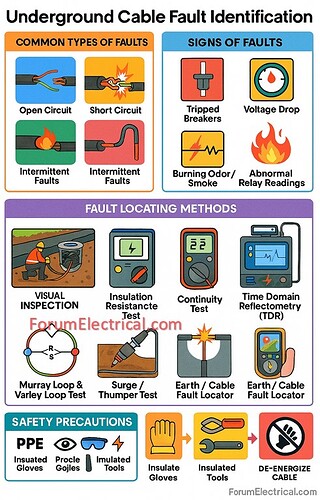Underground cables are key components of electricity distribution systems. Faults in these lines can cause power outages, equipment damage & safety issues. Maintenance personnel want the ability to identify defects promptly and accurately.
Common Types of Underground Cable Faults
Open Circuit Fault (OC): A complete breakdown in the conductor.
Short Circuit Fault (SC): Short Circuit Fault (SC) occurs when a conductor contacts another phase (or) ground.
Insulation Fault / Earth Fault: Conductor insulation is destroyed resulting in leakage current.
Intermittent Faults: A fault occurs under particular conditions (for example, damp soil).
Signs of Underground Cable Faults
Tripping circuit breakers or fuses.
Unexpected loss in voltage (or) power outage in a network segment.
Burning odor or smoke from the cable route (not common but essential).
Abnormal readings in protective relays (or) monitoring systems.
Safety Precautions
If feasible always de-energize the cable before testing.
Use appropriate PPE (gloves, goggles, and insulated tools).
When conducting live tests, adhere to local electrical safety guidelines.
Methods for Locating Underground Cable Faults
Visual Inspection
Inspect cable routes for exposed cables, manholes or excavation sites.
Useful for recent installation issues or physical damage.
Insulation Resistance Test
To measure insulation resistance, use an IR tester (Megger).
Low resistance implies insulation failure or moisture intrusion.
Continuity Test
Checks for open circuits with a multimeter (or) continuity tester.
Ensures that the conductor is not broken along the way.
Time Domain Reflectometry (TDR)
Sends a pulse through the cable & measures the reflected signal.
Determines the distance to the fault in meters.
Works well with open, short & high-resistance faults.
Murray Loop and Varley Loop Test
The classical method employs a resistance bridge.
Compares the resistance of the faulty cable to a known healthy conductor.
Determines fault location accurately, particularly for metallic wires.
Surge/Thumper Test
A high-voltage pulse is used to generate a sound at the problem area.
Frequently used to identify high-resistance or intermittent problems.
Due to the high voltage, it must be handled with caution.
Earth Fault Locator or Cable Fault Locator
Modern electrical equipment developed to test underground cables.
Can identify phase-to-earth & phase-to-phase faults.
Frequently combined with GPS and a digital readout for faster troubleshooting.
Summary
Identifying subterranean cable issues requires a combination of:
Observing system behavior (trips and outages).
Performing electrical testing (IR, continuity, and TDR).
Using advanced fault-finding techniques (Murray loop, surge test, electronic locators).
You can also follow us on AutomationForum.co, Facebook and Linkedin to receive daily Instrumentation updates.
You can also follow us on ForumElectrical.com , Facebook and Linkedin to receive daily Electrical updates.
